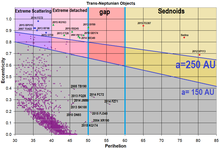2014 ST373
| Discovery[1][2] | |
|---|---|
| Discovered by | CTIO-DECam (first observed only) |
| Discovery date | 25 September 2014 |
| Designations | |
| 2014 ST373 | |
| TNO[3][4] · detached distant[1] | |
| Orbital characteristics[3] | |
| Epoch 31 May 2020 (JD 2459000.5) | |
| Uncertainty parameter 5[3] · 3[1] | |
| Observation arc | 792 d |
| Aphelion | 158.86 AU |
| Perihelion | 50.20 AU |
| 104.53 AU | |
| Eccentricity | 0.52 |
| 1069 yr | |
| 353.71° | |
| 0° 0m 3.24s / day | |
| Inclination | 43.158° |
| 130.218° | |
| ≈ 14 July 2039[5] ±4 months | |
| 297.117° | |
| Physical characteristics | |
| 370 km (est at 0.09)[6] | |
| 5.4[1][3] | |
2014 ST373 (prov. designation: 2014 ST373) is a trans-Neptunian object and a detached object from the outermost region of the Solar System. With a perihelion of 50.2 AU, it belongs to the top 10 minor planets with the highest known perihelia of the Solar System.[a] and is neither a scattered disc nor an extreme trans-Neptunian object. It measures approximately 370 kilometers (230 miles) in diameter and was first observed on 25 September 2014, by astronomers using the Dark Energy Camera (DECam) at Cerro Tololo Inter-American Observatory in Chile.[1]
Orbit and classification
2014 ST373 orbits the Sun at a distance of 50.2–158.9 AU once every 1069 years; semi-major axis of 104.53 AU. Its orbit has an eccentricity of 0.52 and an inclination of 43.16° with respect to the ecliptic.[3]
2014 ST373 is a distant minor planet and trans-Neptunian object (TNO) beyond the orbit of Neptune and the Kuiper cliff.[3][4] As of February 2020, it has the 8th highest perihelia of all known minor planets. Based on a still sufficiently determined perihelion a of 50.2 AU, it is not a member of the scattered disc population, as these objects are thought to have been ejected from the classical Kuiper belt into their current orbits by gravitational interactions with Neptune (semi-major axis of 30.1 AU), and typically have highly eccentric orbits and perihelia of less than 38 AU. 2014 ST373's orbit, however, has never brought it close enough to Neptune to be gravitational disturbed.
On the other hand, this TNO is not an extreme trans-Neptunian object as these objects generally have higher perihelia and/or higher eccentricities. Instead, it is located in a virtually unpopulated region at a perihelion of 50 AU and an eccentricity of 0.5 (see adjunct images, where the grid crosses at q=50 AU and e=0.5)
The Kozai mechanism is capable of transferring orbital eccentricity to a higher inclination.[7][8] It can be speculated that this dynamical phenomenon also affected the orbit of 2014 ST373. If this was the case, and the object had once belonged to the extreme detached disc objects – which have eccentricities above 0.8 and semi-major axes of at least 250 AU, for a perihelion of 50 AU – the Kozai effect would have slowly decreased 2014 ST373's aphelion from over 450 AU to currently 159 AU while increasing its inclination. 2014 ST373 seems to belong to the same group as 2004 XR190.[citation needed]
Physical characteristics
Diameter and albedo
Based on an absolute magnitude of 5.4,[1] and an assumed astronomical albedo of 0.9, which is a standard default value adopted for trans-Neptunian objects by Johnston's archive,[9] 2014 ST373 measures approximately 370 kilometers (230 miles) in diameter.[6] The body's color, rotation period, pole and shape remain unknown.[3][10]
Notes
- ^ Data Base Query, at the JPL Small-Body Database: all objects with a perihelion (q) larger than 38 AU; sorted in descending order. In February 2020, 2014 ST373 ranks #8 among objects with the highest perihelion. Top objects in the list: (#1) 2012 VP113, (#2) 90377 Sedna, (#3) 541132 Leleākūhonua, (#4) 2014 FZ71, (#5) 2014 FC72, (#6) 2004 XR190 and (#7) 2015 FJ345.
References
- ^ a b c d e f "2014 ST373". Minor Planet Center. Retrieved 19 February 2020.
- ^ "MPEC 2020-C88 : 131 NEW DISTANT OBJECTS". Minor Planet Electronic Circular. Minor Planet Center. 4 February 2020. Retrieved 19 February 2020.
- ^ a b c d e f g "JPL Small-Body Database Browser: (2014 ST373)" (2016-11-25 last obs.). Jet Propulsion Laboratory. Retrieved 19 February 2020.
- ^ a b "List Of Transneptunian Objects". Minor Planet Center. Retrieved 19 February 2020.
- ^ JPL Horizons Observer Location: @sun (Perihelion occurs when deldot changes from negative to positive. Uncertainty in time of perihelion is 3-sigma.)
- ^ a b "Asteroid Size Estimator". CNEOS NASA/JPL. Retrieved 19 February 2020.
- ^ Sheppard, Scott S.; Trujillo, Chadwick; Tholen, David J. (July 2016). "Beyond the Kuiper Belt Edge: New High Perihelion Trans-Neptunian Objects with Moderate Semimajor Axes and Eccentricities". The Astrophysical Journal Letters. 825 (1): 7. arXiv:1606.02294. Bibcode:2016ApJ...825L..13S. doi:10.3847/2041-8205/825/1/L13. S2CID 118630570. (Discovery paper)
- ^ Allen, R. L.; Gladman, B.; Kavelaars, J. J.; Petit, J.-M.; Parker, J. W.; Nicholson, P. (March 2006). "Discovery of a Low-Eccentricity, High-Inclination Kuiper Belt Object at 58 AU". The Astrophysical Journal. 640 (1): L83 – L86. arXiv:astro-ph/0512430. Bibcode:2006ApJ...640L..83A. doi:10.1086/503098. S2CID 15588453. (Discovery paper)
- ^ Johnston, Wm. Robert (27 December 2019). "List of Known Trans-Neptunian Objects". Johnston's Archive. Retrieved 22 February 2020.
- ^ "LCDB Data for (2014+ST373)". Asteroid Lightcurve Database (LCDB). Retrieved 19 February 2020.




